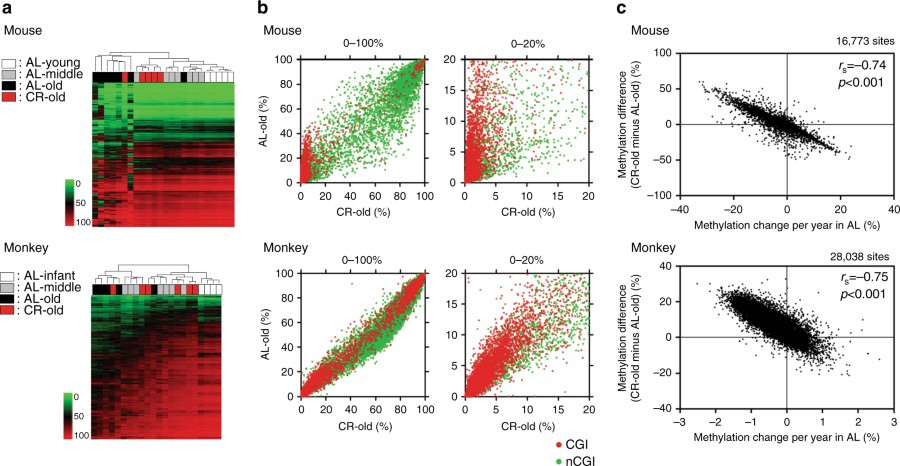
DREAM analysis in CR animals. a Unsupervised hierarchical clustering analysis of methylation values in all genomic regions. The green to red scale indicates the methylation percentage. The color codes for age and caloric status are shown on the left. b DNA methylation in AL old animals vs. CR old animals. Average DNA methylation level of each CpG site in CR old individuals (x axis), methylation in AL old individuals is shown on the y axis. The red and green dots represent CpG sites within CGI and non-CGI, respectively. The full range (0–100%) of methylation level is shown on the left and the low range (0–20%) is magnified and shown on the right. c Correlation between the effects of CR and age-related methylation drift in AL animals. The x axis shows methylation changes per year in AL-fed animals. Positive/negative value means methylation increase/decrease with age, respectively. The y axis shows the differences of methylation percentage between CR old and AL old animals. Each dot represents a CpG site. Spearman r values and the corresponding two-tailed p-values were calculated
Almost a century ago, scientists discovered that cutting calorie intake could dramatically extend lifespan in certain animal species. Despite numerous studies since, however, researchers have been unable to explain precisely why. Now, investigators at the Lewis Katz School of Medicine at Temple University (LKSOM) have broken past that barrier. In new work they are the first to show that the speed at which the epigenome changes with age is associated with lifespan across species and that calorie restriction slows this process of change, potentially explaining its effects on longevity.
“Our study shows that epigenetic drift, which is characterized by gains and losses in DNA methylation in the genome over time, occurs more rapidly in mice than in monkeys and more rapidly in monkeys than in humans,” explains Jean-Pierre Issa, MD, Director of the Fels Institute for Cancer Research at LKSOM, and senior investigator on the new study. The findings help to explain why mice live only about two to three years on average, rhesus monkeys about 25 years, and humans 70 or 80 years.
Chemical modifications such as DNA methylation control mammalian genes, serving as bookmarks for when a gene should be used – a phenomenon known as epigenetics. “Methylation patterns drift steadily throughout life, with methylation increasing in some areas of the genome, and decreasing in others,” says Dr. Issa. Previous studies had shown that these changes occur with age, but whether they were also related to lifespan was unknown.
Dr. Issa’s team made their discovery after first examining methylation patterns on DNA in blood collected from individuals of different ages for each of 3 species – mouse, monkey, and human. Mice ranged in age from a few months to almost three years, monkeys from less than one year to 30 years, and humans from age 0 to 86 years (cord blood was used to represent age zero). Age-related variations in DNA methylation were analyzed by deep sequencing technology, which revealed distinct patterns, with gains in methylation in older individuals occurring at genomic sites that were unmethylated in young individuals, and vice versa.
In subsequent analyses, striking losses in gene expression were observed in genomic regions that had become increasingly methylated with age, whereas regions that had become less methylated showed increases in gene expression. Investigation of a subset of genes affected by age-related changes in methylation revealed an inverse relationship between methylation drift and longevity. In other words, the greater the amount of epigenetic change – and the more quickly it occurred – the shorter the species’ life.
“Our next question was whether epigenetic drift could be altered to increase lifespan,” says Dr. Issa. One of the strongest factors known to increase lifespan in animals is calorie restriction, in which calories in the diet are reduced while still maintaining intake of essential nutrients. To examine its effects, the researchers cut calorie intake by 40% in young mice and by 30% percent in middle-aged monkeys. In both species, significant reductions in epigenetic drift were observed, such that age-related changes in methylation in old animals on the calorie-restricted diets were comparable to those of young animals.
With the latest findings, Dr. Issa and colleagues are able to propose a new mechanism – the slowing of epigenetic drift – to explain how calorie restriction prolongs life in animals. “The impacts of calorie restriction on lifespan have been known for decades, but thanks to modern quantitative techniques, we are able to show for the first time a striking slowing down of epigenetic drift as lifespan increases,” he says.
The findings have important implications in health research, where recent studies have suggested that greater amounts of epigenetic drift increase the risk of age-related diseases, including cancer. “Our lab was the first to propose the idea of modifying epigenetic drift as a way of modifying disease risk,” says Dr. Issa. “But why epigenetic drift occurs faster in some people and slower in others is still unclear.”
Dr. Issa’s team hopes to soon identify additional factors that impact methylation drift. Such factors could potentially be altered to slow drift, having major impacts on age-related disease prevention. http://www.templehealth.org/News/TempleResearchersUncoverMechanismBehindCalorieRestrictionandLengthenedLifespan?showBack=true https://www.nature.com/articles/s41467-017-00607-3








Recent Comments